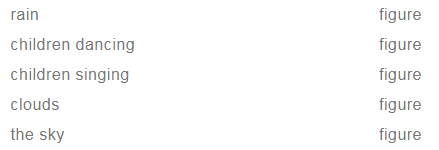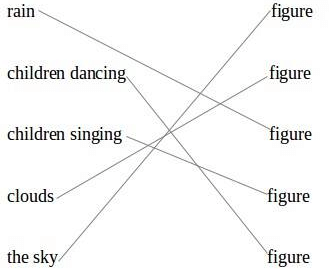Clouds NCERT Solutions | NCERT Textbooks & Solutions (Class 1 to Class 5) - DSSSB TGT/PGT/PRT PDF Download
Page No 98:
Question 1: Learn New Words
A) Bring
B) Cloud
C) Cool
D) Dance
E) Hot
F) Rain
Answer:
A) Bring: To come with something to a place Example sentences:
1) I bring my books daily to the classroom.
2) Bring me an ice-cream from the shop.
B) Cloud: A white or grey mass of water in the sky Example sentences:
1) The sun was behind the cloud.
2) Look at that white cloud.
C) Cool: Neither cold nor warm Example sentences:
1) I could feel the cool breeze in my hair.
2) We sang the song on a cool summer evening.
D) Dance: Movement of body in rhythm Example sentences:
1) There is a dance competition in our class.
2) I watched a dance show yesterday.
E) Hot: Having a high temperature Example sentences:
1) The weather is hot and humid.
2) The food was served hot.
F) Rain: Water that falls from the clouds Example sentences:
1) My mother asked me not to play in the rain.
2) We had to cancel our trip because of the rain.
Page No 99:
Question 1:
- What is the colour of the sky?
- What do the clouds bring?
Answer:
- The sky is blue in colour.
- The clouds bring rain.
Question 2:
- What is the colour of the clouds that bring us rain?
- Do you like to sing and dance in the rain?
- What keeps you dry in the rain?
Answer:
- Dark grey colour clouds bring us rain.
- Yes, I like to sing and dance in the rain.
- Either an umbrella or a raincoat keeps me dry in the rain.
Disclaimer: These are sample answers. The students are advised to write the answers based on their own experiences and observations.
Question 3:
- What do you like to do when it rains? (stay in/go out)
- Do you like puddles?
- The other seasons in India are hot and cold. Describe in your language which season you like the best. Now can you say this in English?
Trace along the dots.
Disclaimer: Kindly refer the textbook for the images.
Answer:
- I like to go out and sing and dance in the rain.
- Yes, I like puddles. When it rains, I go along with my friends to jump and play in the puddles.
- I like cold season the best. It is called winter.
Disclaimer: These are sample answers. Students are advised to write the answers based on their own experiences and observations.
Disclaimer: Join the dotted lines in the given sequence.
Page No 100:
Question 1: Say aloud Answer:
Answer:
Disclaimer: Students are advised to practice this on their own.
Question 2: Match the words with the pictures.
Disclaimer: Kindly refer the textbook for the images. Answer:
Answer:
Page No 101:
Question 1: Let's read and write Answer:
Answer:
Disclaimer: Join the dotted lines to form the given alphabets.
Page No 102:
Question 1:
Fill in the blanks
I can read my name.
My name is ________ .
I am ________ years old.
I can write my address ________ .
I can count till ________ . (10/20/30/40/50)
My teacher’s name is ________ .
I study in class ________ (one).
The name of my school is ________ .
It is in ________ (city).
Answer:
I can read my name.
My name is Priya Bakshi.
I am five years old.
I can write my address B-110, Rail Nagar Apartments, Sector 50, Noida.
I can count till 50 . (10/20/30/40/50)
My teacher’s name is Miss Reena Agarwal.
I study in class one (one).
The name of my school is Little Angels High School.
It is in Noida(city).
Disclaimer: The answer to this question may vary from student to student.
FAQs on Clouds NCERT Solutions - NCERT Textbooks & Solutions (Class 1 to Class 5) - DSSSB TGT/PGT/PRT
| 1. What are clouds and how are they formed? |  |
| 2. What are the different types of clouds? |  |
| 3. How do clouds affect weather patterns? |  |
| 4. Can clouds cause thunderstorms and lightning? |  |
| 5. How do clouds impact climate change? |  |
















